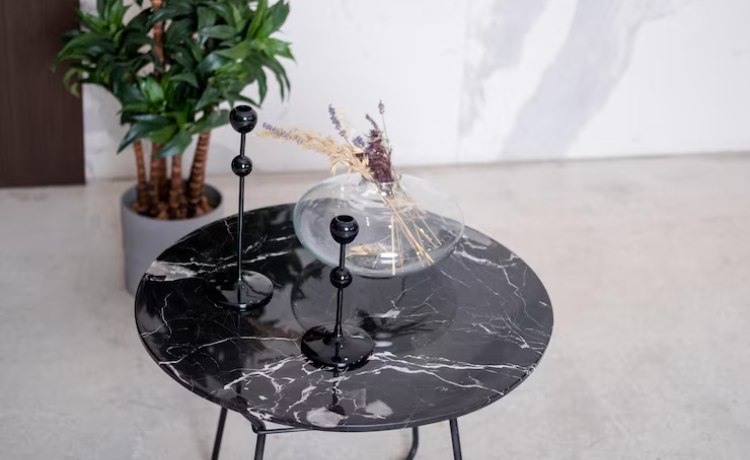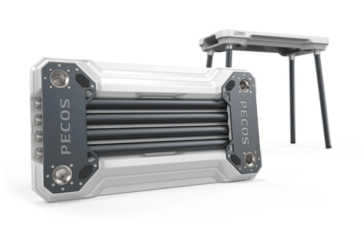A marble side table is more than just a piece of furniture; it’s a statement of elegance and timeless style. Whether your home is a minimalist modern sanctuary or a traditionally decorated space, the right marble side table can elevate its aesthetic. Their enduring popularity in interior design isn’t a fleeting trend but a testament to their versatility and lasting beauty. From adding a touch of luxury to a living room to providing a chic surface in a bedroom, these tables blend function with high-end style.
This guide will walk you through everything you need to know about choosing, styling, and caring for a marble side table. We will explore different styles, examine material quality, offer practical purchasing advice, and provide maintenance tips to ensure your investment remains beautiful for years to come. By the end, you’ll have all the information needed to select the perfect piece for your home.
Understanding Marble Side Tables: Types and Styles
When you start looking for marble side tables, you’ll quickly notice the variety available. The type of marble and the design style play significant roles in the table’s overall look and feel.
There are several types of marble used for furniture, each with unique characteristics. Carrara marble, from Italy, is one of the most common, known for its subtle gray veining on a white or blue-gray background. Calacatta marble, also from Italy, is rarer and more luxurious, featuring dramatic, thick veining on a bright white field. For a darker, more dramatic look, Emperador marble from Spain offers rich brown tones with intricate veining.
Popular marble side table designs range from classic to contemporary. Round and square tables are timeless choices that fit easily into most layouts. For a more modern aesthetic, you might consider geometric shapes or minimalist designs with sleek metal bases. A minimalist table with a thin, brass-finished frame and a clean white marble top can complement a modern living room, while a traditional table with a carved wooden base and a classic Carrara top fits beautifully in a rustic or classic home. The key is matching the table’s design to your existing home décor.
What to Know About Marble Quality
Marble’s appeal comes from its natural beauty and durability, but not all marble is created equal. Understanding how to identify quality is crucial for making a good investment.
High-quality marble typically has a smooth, polished finish with consistent coloring and minimal cracks or fissures. Veining should appear natural and integrated into the stone, not like surface-level scratches. Lower-grade marble may have a duller appearance or contain more “fill,” which is a resin used to patch natural imperfections. When shopping, run your hand over the surface to feel for smoothness and inspect it under good lighting to check for inconsistencies.
Like any material, marble has its pros and cons. Its biggest advantage is its timeless aesthetic; a marble side table will never go out of style. It is also quite durable and can withstand daily use. However, marble is heavy, which can make it difficult to move. It is also a porous stone, making it prone to staining from spills like wine or coffee if not sealed properly. Compared to wood, marble offers a more luxurious and formal feel. Against glass, it provides more visual weight and substance.
Choosing the Right Marble Side Table
Selecting the perfect marble side table involves more than just picking a design you like. You need to consider your room’s size, layout, and existing décor.
For a spacious living room, a larger, more substantial table can act as a centerpiece. In a smaller bedroom, a petite, round table might be a better fit, providing a surface for a lamp or book without overwhelming the space. Consider the table’s height in relation to your sofa or bed; it should be at a convenient level for placing a drink or a remote.
The shape also matters. A round marble side table can soften a room with lots of angular furniture, while a square table can provide a sense of order and symmetry. Think about its function. Will it primarily hold decorative items, or do you need it to be a practical surface for everyday items? To complement your table, consider placing a simple vase with fresh flowers, a stylish table lamp, or a stack of your favorite coffee table books on top.
Finding and Buying Quality Marble Side Tables
The price of marble side tables can vary widely, influenced by factors like the type and quality of the marble, the complexity of the design, and the craftsmanship. A simple table with a Carrara top might be relatively affordable, while a custom piece made from rare Calacatta marble will be a significant investment.
You can buy marble side tables from a variety of retailers. High-end furniture chains and boutique stores often have curated collections with unique designs. Online retailers like Wayfair, West Elm, and CB2 offer a wide selection at different price points. Keep an eye out for sales, especially during holiday weekends or end-of-season events, to find affordable marble tables without compromising on quality. When reading marble side table reviews, pay attention to comments about durability, shipping, and the accuracy of the product photos.
How to Care for Your Marble Side Table
Proper care is essential to keep your marble side table looking its best. With the right maintenance, you can prevent stains and damage, preserving its natural shine for years.
For daily cleaning, simply wipe the surface with a soft, damp cloth and a pH-neutral cleaner. Avoid using acidic or abrasive cleaners like vinegar, lemon juice, or harsh scrubbing powders, as these can etch the marble’s surface. To prevent stains, always use coasters for drinks and wipe up spills immediately. Sealing your marble table periodically typically once or twice a year will create a protective barrier against moisture and stains. If a chip or crack does occur, small imperfections can often be repaired by a professional.
Decorating with Marble Side Tables
A marble side table can be a stunning focal point or a subtle complement to your room’s décor. Styling it effectively will enhance your home’s aesthetic.
Don’t be afraid to mix materials. A marble side table with a metal base pairs beautifully with a plush velvet sofa or a rustic wooden coffee table. The contrast in textures adds depth and visual interest to the space. For lighting, a sculptural lamp with a warm-toned shade can create an inviting glow on the marble surface. Accessorize with items that reflect your personal style, such as decorative trays, scented candles, or small art pieces. Whether in the living room, bedroom, or even a home office, a marble side table adds a touch of sophistication.
DIY & Customization Options
For the more hands-on homeowner, customizing or even making a marble side table can be a rewarding project. While cutting and polishing marble requires specialized tools and skills, you can find pre-cut marble tops online or at stone yards. You can then pair the top with a custom base made from wood, metal, or even concrete to create a unique piece.
Another option is to refinish or repurpose an old marble side table. If you find a vintage piece with a damaged base, you can replace it with a new one to give the table a modern update. You could also have the marble top professionally polished to restore its shine. This approach allows you to create a custom look that perfectly suits your style.
Finding the Best Marble Side Table Brands
Several reputable brands are known for their high-quality marble side tables. Brands like Restoration Hardware and Pottery Barn offer classic, durable designs that are built to last. For more contemporary styles, check out retailers like Blu Dot and Article. When looking for the best marble side table brands, seek out reviews that speak to the quality of the materials and the sturdiness of the construction. A good investment piece will have a well-crafted base and a high-grade marble top that is properly sealed.
You would also like: “side tables and“
Is a Marble Side Table the Right Choice?
A marble side table is an investment in timeless style and durability. It offers a unique blend of natural beauty and functional design that can enhance any room. Before purchasing, consider the design that best fits your home, the level of care you are willing to provide, and your budget. By making an informed decision, you can choose a piece that you will love and appreciate for years to come. A marble side table isn’t just furniture, it’s a piece of art that brings a touch of luxury to your everyday life.
Frequently Asked Questions
Is marble suitable for every type of home décor?
Yes, marble is incredibly versatile. For modern or minimalist homes, a table with clean lines and a metal base works well. In traditional or rustic settings, a table with a wooden base or more ornate details can be a great fit. The key is to choose a design and marble type that complements your existing color palette and furniture.
How can I tell if my marble side table is real?
Real marble has a few tell-tale signs. It feels cool to the touch and is quite heavy. Its veining patterns are unique and irregular, unlike the uniform patterns often found in faux marble. You can also perform a small scratch test in an inconspicuous area; real marble is relatively soft and can be scratched with a knife, whereas many synthetic materials are more resistant.
What’s the difference between marble and quartz for side tables?
Marble is a natural stone, celebrated for its unique veining and luxurious appearance. It is porous and requires regular sealing to prevent stains. Quartz is an engineered stone made from crushed quartz crystals and resin. It is non-porous, making it more resistant to staining and easier to maintain. While quartz can mimic the look of marble, it lacks the one-of-a-kind patterns found in natural stone.
Can marble side tables be used outdoors?
It is generally not recommended to use marble side tables outdoors. Marble is porous and can absorb moisture, which can cause damage, staining, or cracking, especially in freezing temperatures. Exposure to direct sunlight can also cause the color to fade over time. For outdoor use, it’s better to choose materials designed to withstand the elements, like sealed concrete, teak, or powder-coated metal.












